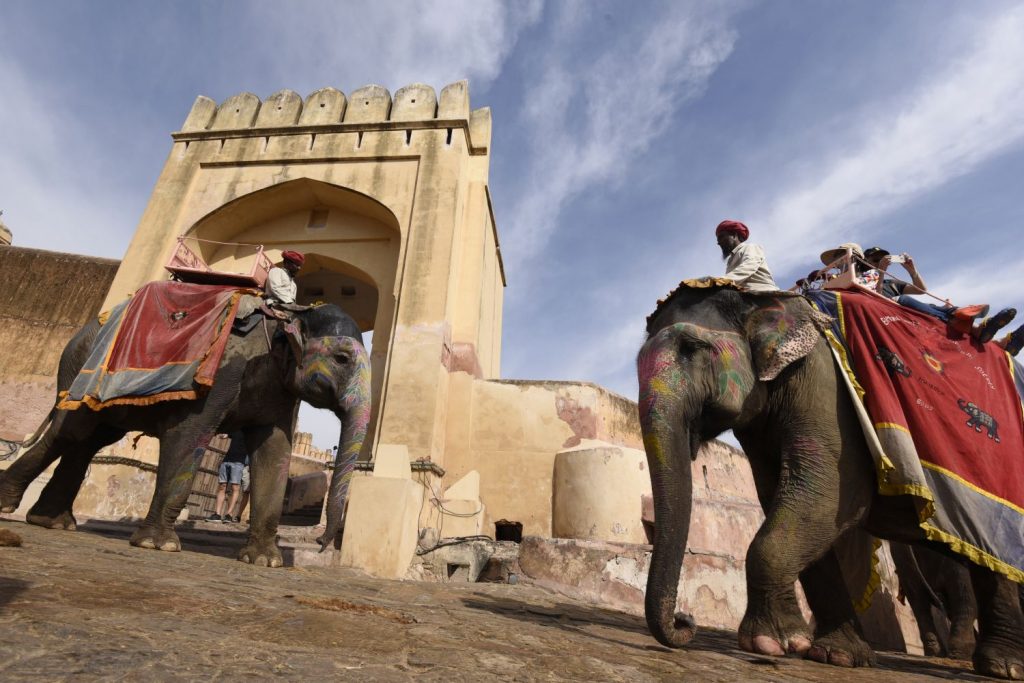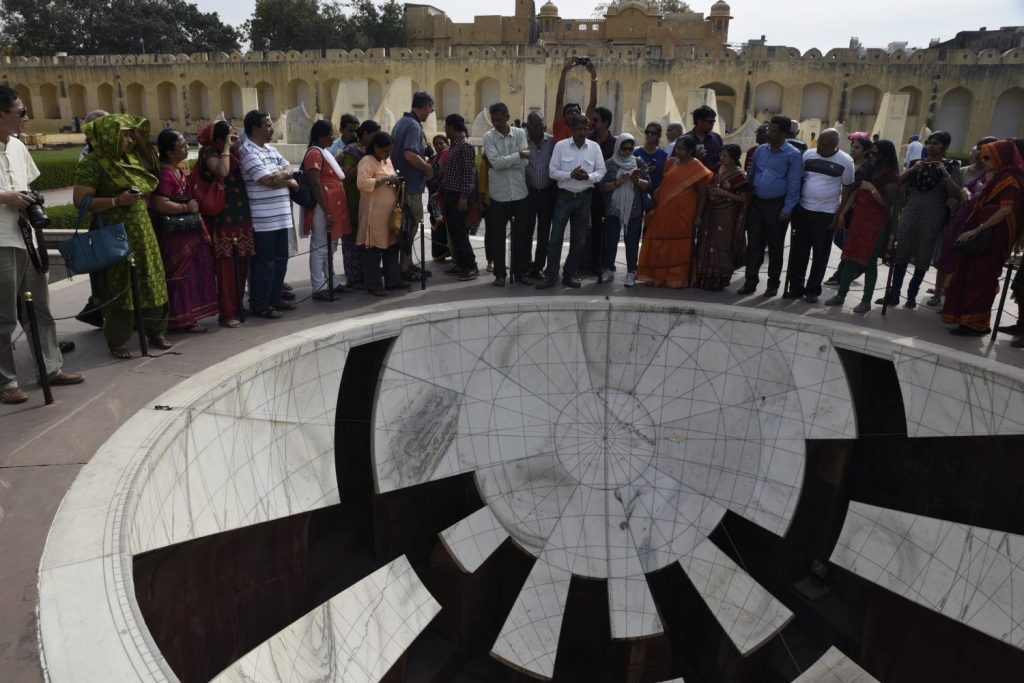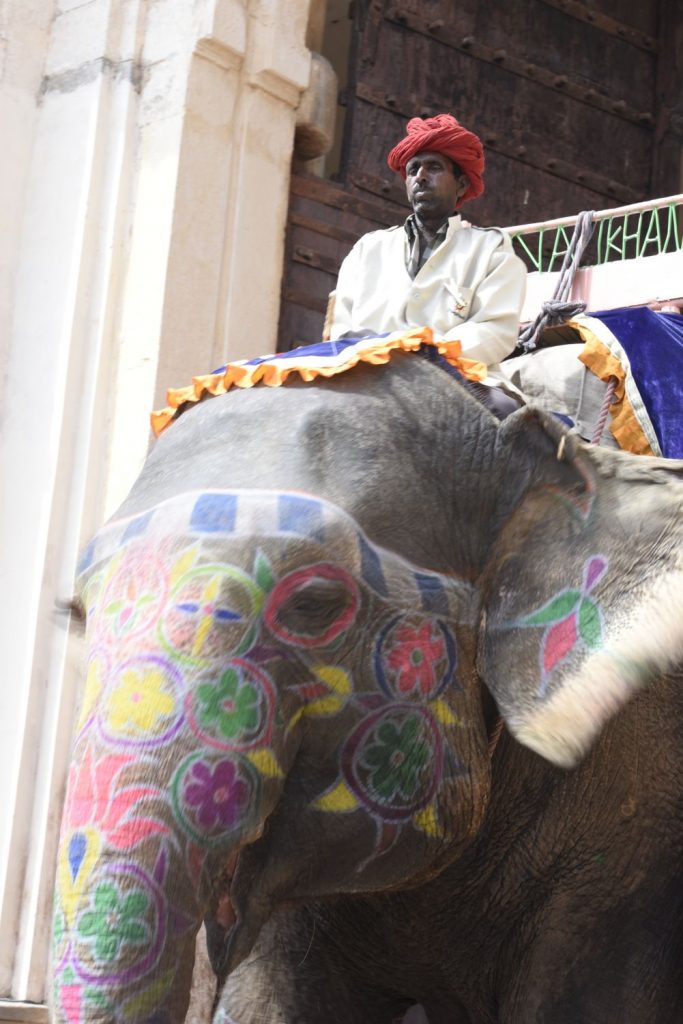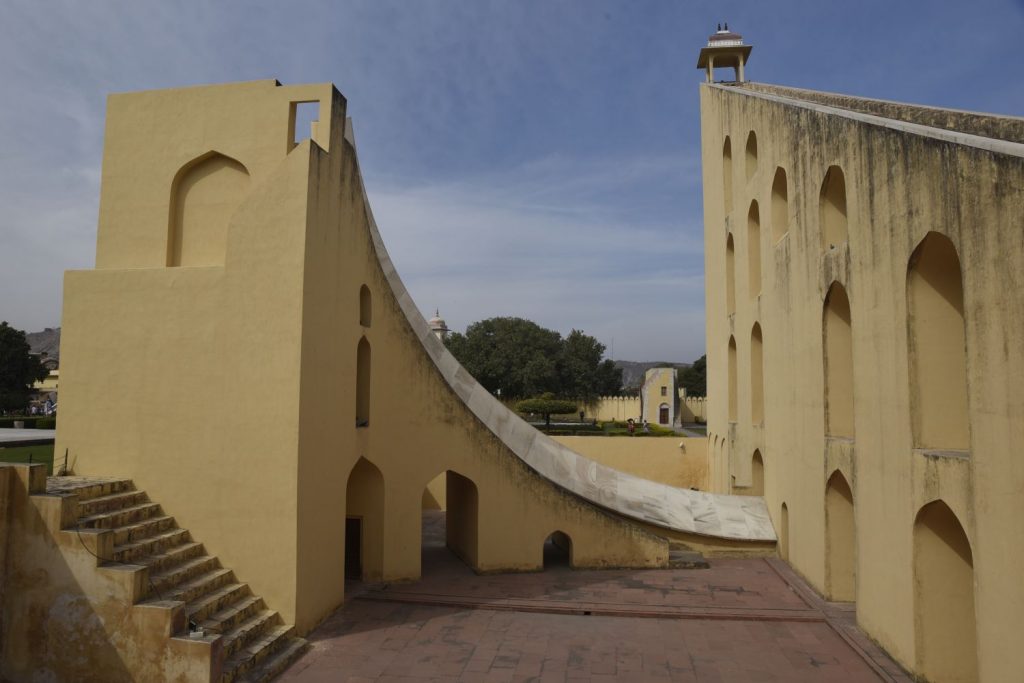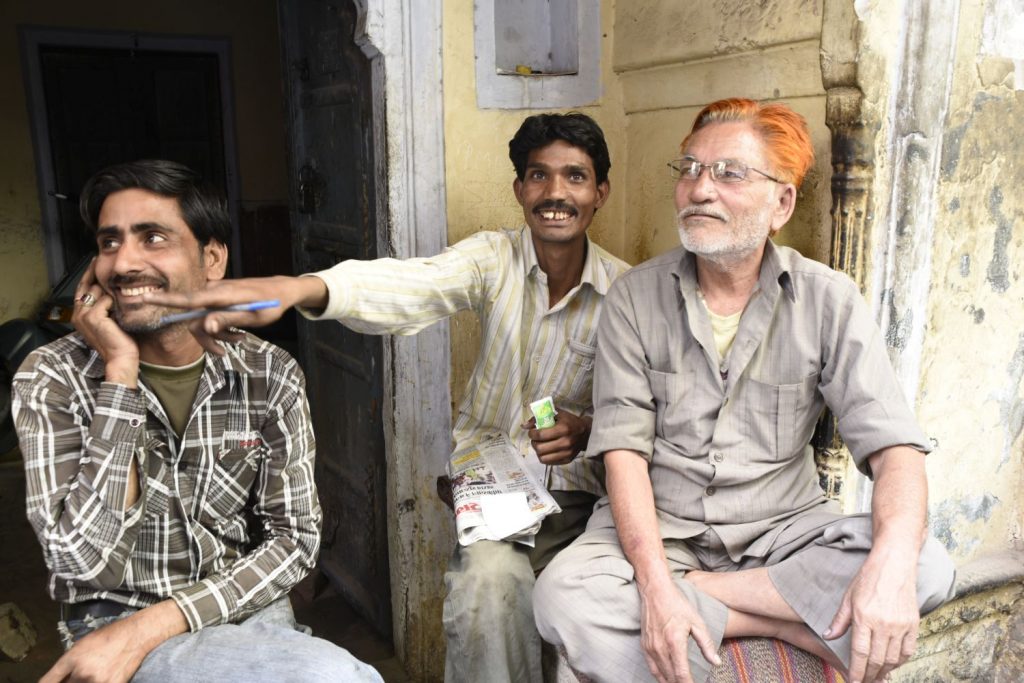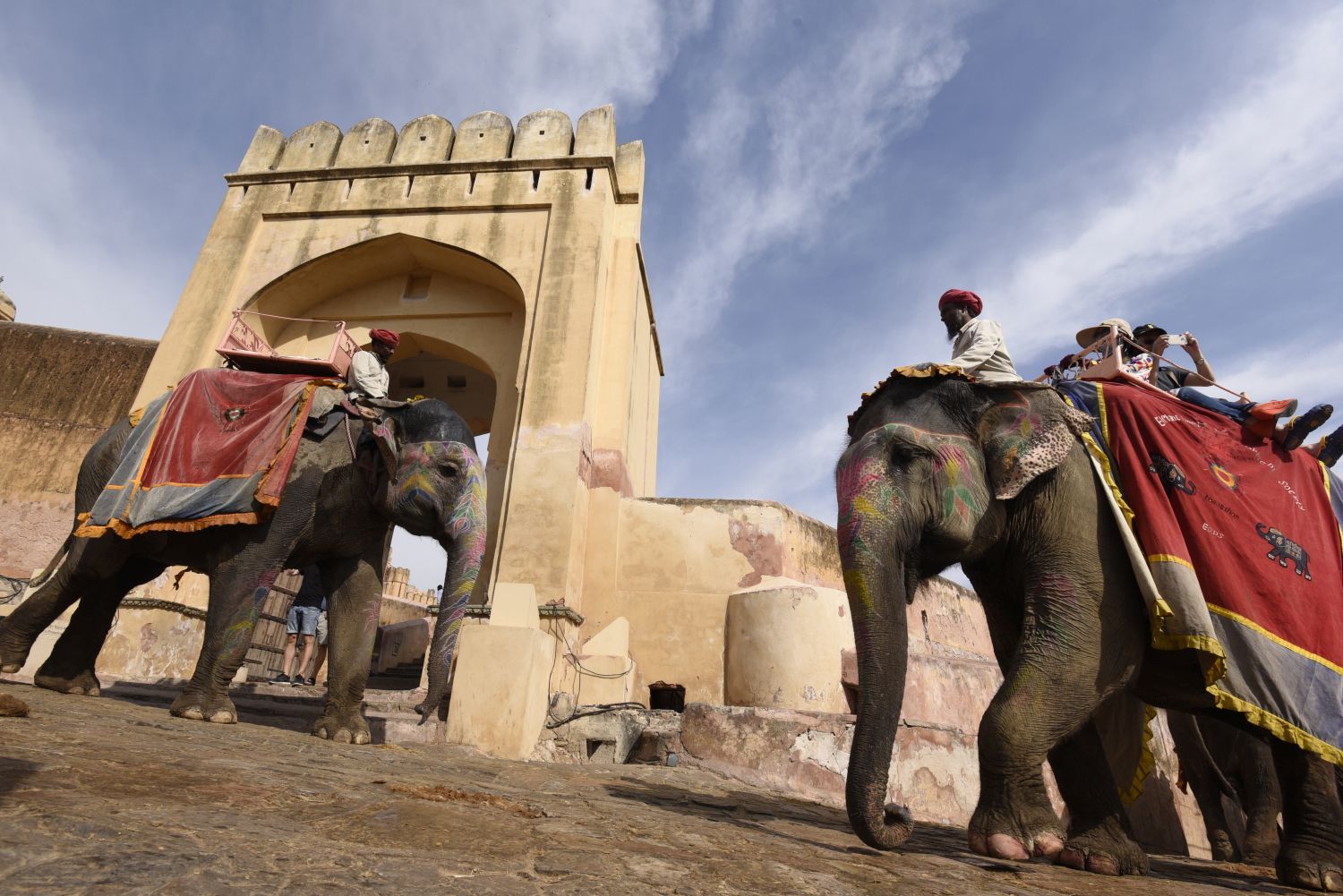
Jaipur is an intense, but fascinating city.
Bus loads of package tourists arrive at the base of the Amber Fort just outside the city to ride elephants up the winding road to the fort. I saw more foreign tourists here than in all other places I visited in India this trip combined. (I haven’t been to Agra yet, so that will change).
Although there are many independent travellers on tight budgets, there are also tourists with money to burn, or who have no idea what a rupee is worth. As a result, prices are jacked up for foreigners everywhere, there is constant hard sell. Buying many things, such as an auto rickshaw ride, requires hard bargaining.
But Jaipur also has many redeeming features. Unfortunately in my one day here, I didn’t have nearly enough time to do it justice.
The old city was planned and laid out in a grid under Maharaja Jai Singh II in 1727. Its buildings are pink, originally a colour of welcome, and have earned it the moniker of “The Pink City” — appropriate for Rajasthan in which Jodhpur is the Blue City, Udaipur is the White City and Jaisalmer is the Golden City.
Based on Jai Singh’s plans, the bazaars are organized according to trades, and even today sellers of similar products are grouped together.
There aren’t the winding alleys of other old cities to get lost in, but it makes for fascinating walks nonetheless.
I arrived just after 5:30 a.m. on the train from Bikaner, having only had a few hours of sleep, thanks to a restless young child and constantly fidgeting parents in the seats around me. I tried to let a little time pass at the station to wake up with a couple coffees and to face Jaipur in daylight. As usual in India, most coffee is Nescafe and real coffee is rare.
As I left the station, rickshaw wallahs descended on me quickly. Fortunately there is a pre-paid both at station, as there are in some of India’s other touristy transportation hubs, which sets a fair and fixed rate. My driver did keep pressuring me to go to another hotel where he no doubt gets a commission, but I just insisted that I had a pre-paid hotel reservation and I wasn’t changing.
The hotel, at the edge of the old city, was in an old haveli. Despite the early hour, the young man working the front desk answered my ring and told me I could have a room right away. Music to my ears as I had expected only to be able to leave bags until later in the day when I could check in.
Making this hotel special, they showered me with flower petals thrown from an upper balcony as I was led up the stairs to my room and then front desk man put a red dot on my forehead and a chain of flowers around my neck. Gimmicky, yes, but it was fun and was symbolic of the extra effort the hotel makes to serve guests.
After a snooze and breakfast, I caught a local bus to the Amber Fort for just 15 rupees, no doubt pissing off the rickshaw wallahs who charge hundreds after intense bargaining.
I climbed the hill to the fort, photographing its setting and the many painted elephants carrying tourists to the top, two at a time, while the elephant wallahs rode up on the neck.
The top was absolutely swarming with tourists. I was also feeling like I’d had my fill of forts and palaces and I had already visited Amber in 1977, so I decided to give the inside a pass – especially since I felt pressed for time.
Heading back, a rickshaw wallah told me it was not possible to take a bus. Two minutes later, a bus took me back to town for 10 rupees.
One man shifted his family over and squeezed them so that he could offer me a seat. This is typical of the hospitality of many Indians who are not in the business of fleecing tourists.
Next I began part of a walking tour of the old city that was suggested in my Lonely Planet guide, which included a map and descriptions of the points along the way.
Before visiting Jantar Mantar, an observatory built by Jai Singh, I gave Yogesh a call, which he had asked me to do when I was in Jaipur. He suggested we could get together after he finished work and that I could meet his family.
The Jantar Mantar was quite a work of science for its time. Its many instruments resembled sculptures or strange-shaped buildings. Most were for such things as calculating time, tracking celestial bodies and calculating the signs of the zodiac. They were amazingly accurate, with sun dials that could calculate the time to a two-minute accuracy.
I watched one guide showing a couple tourists how the edge of the sun’s shadow fell across a marker on a rounded marble sculpture. From this marker, the exact solar time of Jaipur could be determined. To this, an offset of 39 minutes was added to reflect the fact that Indian Standard Time is based on Allahabad and to account for seasonal change. The time, the guide announced, was 2:22 p.m. I checked my watch. He was right to the minute.
Another instrument had a concave pit with marble strips at the bottom indicating signs of the zodiac. A circular disk was suspended with wires over the pit and it cast a shadow right in the area indicating Pisces. A guide explained to a group that the shadow was only just past the line separating Pisces from Aquarius. This is because on February 23, we were only a couple days into Pisces.
This was by far the largest of five Jantar Mantars built by Jai Singh in northern India, and is much larger than the one I visited in Ujjain.
From there I strolled through markets, passing sellers devoted to kitchen gadgets, flowers, perfumes, dyes, wrist bangles and other products. Sometimes people were willing to be photographed when I asked. Other times, they asked to be photographed. A common thing in India is that someone will see my camera and ask me to photograph their friend. If the friend acts too shy or insists they don’t want to be photographed, I photograph the person making the request instead. I then show both the photo, which often gets the reluctant person so agree to be photographed after all. Other times, if there’s no resistance, I photograph both together or separately depending on the subjects and location.
While many of the photos I get this way are a little stiff or uninteresting, I have gotten some nice ones.
Often products were being manufactured right at the shops so, at the very least, I stopped to watch. At one shop they were making little containers from lac, a natural resin, which are used to hold the coloured dyes used in the Holi festival. The man there showed me an album of the many awards and recognitions his father received in the business, including meeting such figures as Indira Gandhi, Prince Charles and various other important people. It’s a family business, and his wife and mother were working away shaping and colouring the lac as he talked to me.
When I completed the walk, I had to bargain with auto rickshaw wallahs to get back to my hotel, which was fairly close, but farther than I wanted to walk just then.
One quoted me a price of 100 rupees, which I knew was the foreigner price. There is a code among rickshaw wallahs that they won’t interfere when a customer is bargaining with one, but if negotiations break off, it’s fair for others to jump in with their own prices. As a result, when I get quoted a price that’s too high, I don’t offer a counter price when there are other rickshaw wallahs there. I just say, “no thanks. I’ll walk” and I start walking away. Other wallahs then jump in with a lower price. I got an offer of 80 rupees, but I insisted on walking instead. Another then offered to take me for 70, which is probably higher than what an Indian would pay, but seemed reasonable, so I took it. Such is how it often works in India, especially Jaipur, where rarely is the first price offered the one you actually pay.
After I cleaned up and rested, Yogesh called me to invite me to dinner at his apartment with his family. I met him at the GPO post office where he was working, after my rickshaw driver got lost a couple times – I’m not sure why a rickshaw driver wouldn’t know where the city’s main post office was.
Yogesh drove me to his gated apartment, deftly dodging Jaipur rush hour traffic.
I met his wife, two young daughters, brother-in-law and his son as well as a few other neighbourhood children who dropped by to see the “foreigner.”
His wife, who works as a pre-school teacher, had prepared a wonderful dinner at short notice with two kinds of appetizer I was unfamiliar with, and two delicious vegetarian dishes, one from kidney beans, along with rice and chapattis.
In the end, they gave me a gift of some candles. I felt bad that I hadn’t brought them a gift. We promised to stay in touch through Facebook.
Yogesh and I both enjoyed each other’s company during our adventures in Jaisalmer and Bikaner. He said it was unusual for him to get to know a foreigner this way. For me, I enjoyed his sense of humour and insights on India. It’s rare for me to get to know someone in India who can communicate so well in English.
I got back to my hotel and into bed by midnight with only five hours to sleep before I had to get up for a train to Agra. This will be my last destination in India – crowned with the Taj Mahal – before I return to Delhi and fly home.


